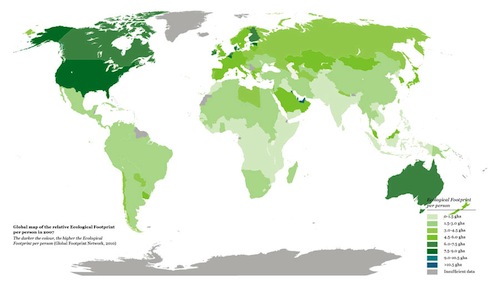
Ahead of Rio+20, yet another major report is released detailing the human impact on the planet.
Every couple of years, WWF International produces a Living Planet report. Chock full of data and illustrations about ecosystem stress, threats to wildlife, and environmental security, the report is required reading for those interested in global sustainability. You can read it online and download pdf versions here, http://wwf.panda.org/about_our_earth/all_publications/living_planet_report/.
Released this month, Living Planet 2012 was prepared in cooperation with the Zoological Society of London and the Global Footprint Network. Not surprisingly, the whole report has been reoriented around the frame of footprint analysis, and concludes that human demands exceed the capacities of natural systems by very wide margins.
These WWF reports are generally great at examining the health and well being of earths other species and biodiversity. So too, the data provides strong evidence for the differential roles that wealth, poverty, population, and land use play in causing environmental harms. These features may be of special interest to those of you who, like myself, have a foot in both animal studies and environmental studies.
The reports are also distinctive in that they argue for both preservation and restoration of biodiversity and ecosystems. This is a very different emphasis than is found in most reports on sustainable development or climate change. The latter tend to emphasis adaptation or mitigation of environmental degradation, and dismiss or peripheralize preserving what remains and restoring some of what has been lost.
Altogether then, the report offers strong justifications for environmental policies designed to bring the carrying capacity of the planet in line with humanitys ecological footprint.
As with the People and the Planet report by The Royal Society, Living Planet 2012 makes overwhelmingly instrumental arguments for the importance of animals and nature. I do wish they would make space or provide additional information on the ethical dimensions of the report. Here is why.
First, the report is chock full of unarticulated moral norms about human health and well being, even as it sidesteps these norms by billing itself as solely a scientific report. As I have noted before, sound science requires sound ethics. Questions of environmental justice and the ethics of sustainability deserve to be brought forward and discussed.
Second, human health and well being is not a strong enough justification for placing so much effort into preservation and restoration. Highly technological societies will most likely survive at much lower levels of biodiversity and ecosystem integrity. They may not be the kind of societies we want to live in, but the reasons for that are not solely about ourselves. The reasons also involve the loss of intrinsic values in the non-human world.
Third, the authors of these reports believe they need to remain value-free in order to retain their credibility. This is nonsense. All public policy is a matter of choosing between values. The science of these reports is very useful in helping us make these choices. Even so, those ethics-laden choices should be directly connected to the scientific information that will help us make better and not worse choices. Hiding the ethical implications of a scientific report detracts from the making of good public policy.
We routinely incorporate science and ethics in medical and health care policy. It is time we started to do so for environmental policy as well.
Image: Global Ecological Footprint, Living Planet 2012, http://wwf.panda.org/about_our_earth/all_publications/living_planet_report/